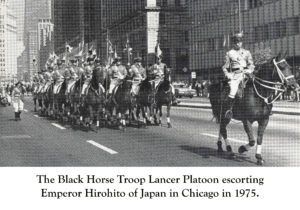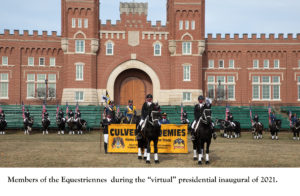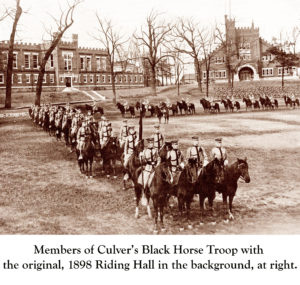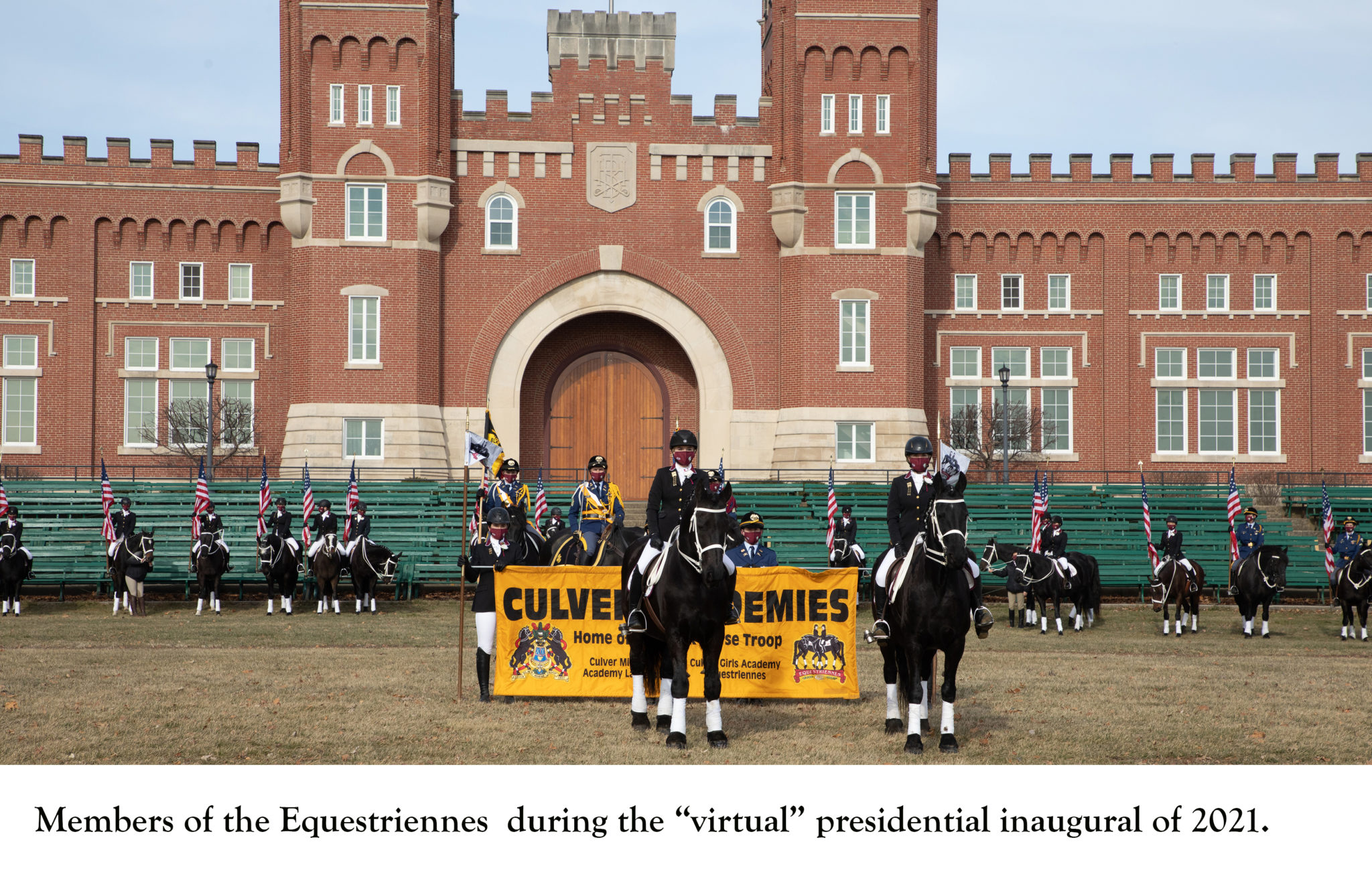On Horseback at Culver
A Proud Tradition on the Regional and International Stage for 125 Years
Writer / Jeff Kenney
Photography Provided
One of the most recognizable facets nationally of Culver Academies and, in a broader sense, northern Indiana, is the horsemanship program, best known simply as Culver’s Black Horse Troop – though there’s much more to the program, which celebrates 125 years since its founding this year, than that specific entity. 
Horsemanship at Culver Academies indeed owes its origins to the Black Horse Troop, originally a unit of the Cleveland Cavalry that wowed the nation in March of 1897 when it escorted President McKinley down Pennsylvania Avenue in Washington, D.C., as part of that year’s inaugural festivities (in those days, inaugural parades were held in March rather than the January time frame of today).
Among those impressed by the pageantry of the troop was a young Virginia Military Institute graduate who had been hired just a few months earlier by Culver Military Academy Founder Henry Harrison Culver to serve as the commandant of cadets at the fledgling school, which had opened its doors less than three years prior in 1894. Leigh Gignilliat would later become superintendent of the school in 1911, a brigadier general in World War I, and a figure of national prominence for his role in the Preparedness Movement of the early 20th century, which helped give birth to the ROTC among other effects.
Perhaps more than any other individual, Gignilliat’s vision and methodology helped put Culver Military Academy on the map internationally, placing its cadets in headlines and newsreels, its name into two Hollywood film titles (“Tom Brown of Culver” in 1932 and “The Spirit of Culver” in 1939), and its graduates among the most accomplished in the nation, not only in their military service but in the business world, the arts, politics and more.
One of Gignilliat’s first endeavors was to recommend to the Culver family the purchase of the mounts of the Black Horse Troop, shortly after the inaugural parade in the spring of 1897. The first 16 horses were soon on campus, and Gignilliat lost no time, in the coming months and few years, in putting them in front of regional audiences. Culver’s Black Horse Troop escorted the governor of Indiana and members of the Grand Army of the Republic, and took part in the World’s Fair in St. Louis (where it served as personal escort to legendary Admiral of the Navy George Dewey) and the Jamestown Exposition in 1907, to name but a few early appearances of note.
By 1898 an impressive red-brick riding hall graced the Culver campus, matching the design by renowned St. Louis architect Albert Knell of the other campus buildings. Cadets in the troop were trained not only in general equitation, but also jumping and rough riding, hearkening back to the hallowed tradition of cavalry in warfare and making for an even more impressive spectacle in newspaper photos, films, postcards and in-person revues.
 By 1906 an accomplished horseman in the form of Spanish-American war veteran and cavalryman Colonel Robert Rossow joined the Culver staff as director of its horsemanship program. One of his first suggestions, met with enthusiastic approval by Gignilliat, was the formation of a summer cavalry program to complement the recently (1902) launched Summer Naval School. This began, in 1907, a long-standing and cherished program in its own right, today known as the Summer School of Horsemanship.
By 1906 an accomplished horseman in the form of Spanish-American war veteran and cavalryman Colonel Robert Rossow joined the Culver staff as director of its horsemanship program. One of his first suggestions, met with enthusiastic approval by Gignilliat, was the formation of a summer cavalry program to complement the recently (1902) launched Summer Naval School. This began, in 1907, a long-standing and cherished program in its own right, today known as the Summer School of Horsemanship.
By 1908 an event that would become a beloved annual tradition began within the summer cavalry program – the troop hike. Initially known as the 100-mile hike, the event took summer cavalry cadets “on the trail” on horseback for miles away from Culver, often journeying through surrounding towns and tent camping along the way. Today the tradition continues, though not with quite the same scope of distance.
Perhaps its most visible manifestation began for the Black Horse Troop in 1913, when former Indiana Governor Thomas Marshall invited the entire Culver corps of cadets to escort him down Pennsylvania Avenue during the inauguration of President Woodrow Wilson, under whom Marshall served as vice president. Culver cadets made an impressive showing at that inaugural and its follow-up in 1917, with the troop in particular appearing in headlines, media photos and film clips.
Through the following decades, members of the Black Horse Troop and its honor organization, the Lancer Platoon, appeared at a wide array of regional and national-level events, escorting a host of dignitaries including President Hoover, World War I Supreme Allied Commander Marshall Foch, the king and queen of Denmark, Emperor Hirohito of Japan, Prince Charles of England and many more. Perhaps as testament to the stature of the troop, two popular juvenile novels were published in the 1950s – “Black Horse of Culver” by Helen Orr Watson, and “Tex Rains, Culver Trooper” by Robert Rossow – in addition to numerous recordings and sheet music compositions paying tribute to the troop (including a march composed by legendary bandleader John Philip Sousa).
In the meantime, a new (and the current) riding hall replaced the 1898 structure. Completed in 1916, Culver’s riding hall was hailed as the largest indoor equestrian center in the U.S., with its massive arena home to polo matches and a variety of riding exhibitions and events. Various additions have graced what is today known as the Vaughn Equestrian Center including, in 2009, a large-scale renovation of the entire facility including the current state-of-the-art stables, which can house some 100 horses.
The 1950s saw efforts by Culver students to revive the inaugural tradition. These finally bore fruit when, in 1957, the troop participated in President Dwight Eisenhower’s second inaugural, beginning a consistent run of inaugural appearances ever since, with only the 1993 parade as an exception.
From the first female students at Culver Military Academy starting in 1957, horsemanship opportunities had been available to young women at the school, even if membership in the Black Horse Troop proper – as a living unit in the military school, which is male only – wasn’t possible. This had only increased by 1965 with the start of the Summer School for Girls, and into the 1970s when equestrian hikes, jumping and polo became available for girls.
In 1978 a girls hunt club evolved into the CGA Equestriennes, the first honor organization for young women at Culver Academies, as of 1980. The Equestriennes can boast of a rich history in their own right, sometimes at events alongside members of the Black Horse Troop or Lancer Platoon, and sometimes in their own unique appearances around the country.
The Equestriennes were invited for the first time to join their troop counterparts in Washington, D.C., for the 1985 Reagan inaugural, though that parade was canceled due to inclement weather. Thus the 1989 inaugural parade was the first for the Equestriennes, who (with the exception of the aforementioned 1993 parade) have joined the troop at every inaugural since.
They have appeared in events surrounding the Indianapolis 500, the Kentucky Derby, the Fort Worth Stock Show, and the renowned World Equestrian Games (sometimes alongside the troop and sometimes on their own), among many others.
Today the rich tradition of horsemanship continues at Culver Academies under the direction of recently installed Director of Horsemanship Captain Sean “Skip” Nicholls, who served since 1991 with the British Armed Forces Household Cavalry Mounted Regiment in London, England, and began his Culver tenure last year.
And so, a century and a quarter later, students at the school continue to learn lessons instilled by four-legged and human instructors, and to enthrall audiences locally, regionally and internationally as they carry on a proud area tradition.







Comments 1
The Starke County Park Department Veteran’s Memorial Committee is hosting the Memorial Day Parade, and this is our first year organizing this event. We would love to lead our parade with a riderless horse, or something honoring our veteran’s. Is this something your group would be interested in being a part of? The Parade will be Monday May 29 at 9am at the County Courthouse in Knox.
Thank You,
Karl Swihart
Veterans Memorial Committee Chairman
574-806–7727
kswihart@cityofknox.net